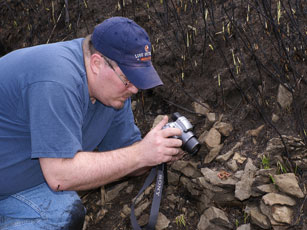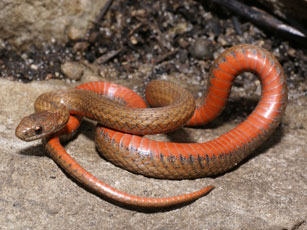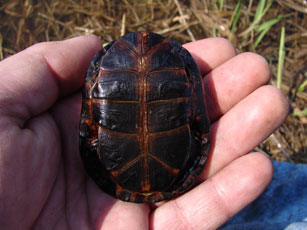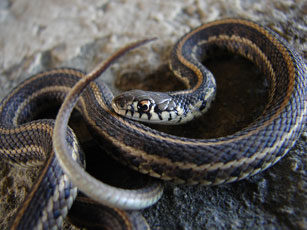
4-20-08
Trip Details
Start Time: 11:30 a.m.
Weather: The morning was foggy, overcast and cool with a temperature of 57 degrees at the start. It gradually warmed and at about 2:30 p.m. finally became sunny with only a few clouds. The high was 69 degrees. Low wind for the majority of the time we were herping.
Location: Bremer County, Iowa
Herper(s): Jim Scharosch, Matt Ricklefs & Jeff LeClere (via phone? - we'll explain)
Account written by Matt Ricklefs
Thought of the Day: "Out of the fog and into the herping season."
The forecast was favorable and yet staring out my bedroom window at 7:30 a.m. did little to booster my herping spirits. As noted above, it was foggy and cool. Visibility was probably about a mile if that. I had not heard from Jim so I figured he was thinking about the same thing I was, 'It looks crappy but it is supposed to turn out OK. Besides, we have a plan and we were going to stick to it!' The main quest today was to search, and hopefully find, the elusive Eastern Massasauga in Iowa. We have some areas that are in the right location and have the correct habitat, but we have not turned up one yet. Massasaugas have been seen in the area however, so we know they are there. After preparing and consuming a quick breakfast, I was on my way to meet at Jim's place. Our meeting time was 9:00 a.m. and we knew we would not leave right away as it would still be somewhat cool we had a little work to do. We have a Kansas herp trip planned for the following weekend and this would give us some time to review supplies and organize a bit. Based on how the weather did turn out, this was a fair plan. When I got to Jim's we commenced reviewing for the Kansas expedition. After about an hour or so, we decided to hit the road.
Photo by Matt Ricklefs
We arrived at out first destination and the weather had not changed a whole lot. It got a little warmer, but not much. This was an area that we had been herping for 20 years or so. At one time, this area did support Massasaugas as we did find them, but they seem to be extirpated at this point. It has been about 18 years since we have seen one at this site. This area has changed quite a lot over the years and was not managed well for a period of time. It has been better managed over the last few years and continues to get better. It had been burned off recently so we had a fairly easy walk. The shoreline is intermixed with rocks to look under. We did not find anything until about half way down. Jim lifted a rock and could not see as far under as from where I was. It was a small rock but toward the back where it lifted I could see a familiar sight, one that we did hope to see. It was a Redbelly Snake (Storeria occipitomaculata).
Photos by Jim Scharosch
I gave the call that Jim had a snake. This one was about six and a half inches in length. Being as this was our first snake of the trip AND of the year, we did spend a little time taking some pictures. Besides, they really are pretty cool little snakes.
We walked the rest of the way we intended to herp and did not find anything else. As is usual, the normal banter was reliving old herp trips. Jim made a rather interesting observation. No matter if you've heard the stories someone is telling they are still interesting. There is not really a story that either of us had not relayed to each other, but they still creep up in conversation and the response is still something like 'that would have been great'. This hold true for whomever you are with. The more people the more fun. It was still cool and overcast, but it was beginning to break up a little. On the walk back we did find a rather chilly Northern Leopard Frog (Rana pipiens) about four inches long.
Photo by Jim Scharosch
Since it was so 'cooperative' and stayed put, we did take some pictures. That was pretty much it for this spot. We did catch a garter snake crossing the road as we left, but decided to get to our next spot and let this one go sans pictures.
This next spot was an area we really hoped to scare up a Massasauga. The weather had finally gotten sunny and it was warming up quickly. Not to keep you in suspense, alas ' no Massasauga. We rustled up a few garters (along with some deer and a pheasant) but that was it. We had put in a good effort however. We hit another area, but flooding had rendered it fairly unherpable (at least for the rocks we planned to uncover) so we moved to our last site.
We needed to navigate to the next spot as it was relatively unfamiliar to us yet.
Photo by Matt Ricklefs
On the road to our intended location we noticed a familiar sight on the side of the road, a dark domed shape. By the time Jim said, 'turtle' I saw it also and was preparing to turn around. He bailed out and grabbed it. As it was it was stationary that worked out quite easy. After a bit of debate and an oddly but fortunately timed phone call by Jeff LeClere we decided that this was a juvenile Blanding's Turtle (Emydoidea blandingii).
Photos by Matt Ricklefs
It had proved difficult as its head was fully retracted and we could not see the tell-tale yellow chin. To compound that, the carapace and plastron were a little darker than what we had seen and could describe to Jeff. There are Wood Turtles in the county, as rare as they are here, so this added some complexity. It was not until we could confirm the yellow chin that we knew for certain. Jeff had called to inquire how we were doing and as serendipity would have it, we were right by the car and Jim had his cell phone right where we could hear it. This was the first time in the day that these conditions were met so that is the irony. So Jeff gets partial credit on the trip for helping ID. This little one was 3 inches long. Although easy to catch, it did not prove easy to photograph. It was more comfortable hiding and did not want to come out. It would come out just a little when placed in water, but would then tuck back in. Patience does prevail (provided you have it and time enough to maintain it) and we did get some acceptable shots. This was a very good find. We had tried to get some pictures of Blanding's basking and had been unable to at this point. The status of the Blanding's Turtle in Iowa is listed as threatened, due mainly to habitat destruction of the marshland habitat it needs, so this was a very welcome find.
The sun was getting lower in the sky, but it was still fairly warm. We were not far from where we photographed the Blanding's Turtle and we were nearing the end of the day. We stopped to look through some rocks and Jim turned up a Northern Water Snake (Nerodia sipedon).
Photos by Jim Scharosch
This one was about eighteen inches long. He had also found a small Plains Garter Snake (Thamnophis radix) that I went back to get pictures of since we had not documented a garter yet.
Photos by Matt Ricklefs
This concluded this site and took us to our last stop.
Photo by Matt Ricklefs
We had hoped for a Fox Snake and a Ribbon Snake (along with the Massasauga) and as fate would have it, we did end on a hoped species. Our last walk produced a Western Ribbon Snake (Thamnophis p. proximus). This one was fair sized at about twenty inches.
Photo by Matt Ricklefs
Photos by Jim Scharosch
This concluded the day. At about this time I realized the error of my ways of underestimating the sun on what started as a cloudy day. I know better, but still seem to forget. As I am writing this I am reminded of my error with the mild heat radiating from my neck and the comments of "you got some sun!" by those who see me (yes..I am a redneck - ha ha ha). Not a bad start of the year - snake wise, not so much with the sun though.
Ya'll stay tuned for the next post!
And as always, Happy herpin'!

















